Forgive the lengthy post. Trying to relate 6 months of my journey to my first wood stove and it can't be done in a short post. I hope this helps other newbies. I enjoyed every minute of picking out my first wood stove, but I admit it can be damn overwhelming to get started! My stove was installed TODAY. I've been doing my first "break in burn" while typing this. Big, dopey grin on my face the whole time!! :D
If you got to this thread googling, “which wood stove is best” I thought I’d type up my experience and thoughts and maybe save you some hours of reading by compiling and paraphrasing others' good advice. I do hope you read a bunch on this forum. I enjoyed it immensely while I was freezing this winter, spending a fortune on propane, and imagining next winter in warmth and bliss... but if you can't spend hours and hours or are in a hurry to get your stove in before winter, maybe this will be useful.
Here is what I gleaned from reading and, most of it reflects my actual process. These thoughts are NOT my original ideas, but things I picked up from reading 100s (probably 1000s) of posts here at hearth.com. This forum is GREAT and the folks here are very knowledgeable and helpful and believe me they want you to LOVE your stove experience so don’t be shy.
1. “Which stove is best” depends on a bunch of factors. The better question is, “which stove is best for my specific situation?” If you’re a newbie, it takes a bit to figure out your specific situation. Face it, we don’t even really know where to start!! Important things to consider are, how big is the space you want to heat? How tall will your chimney have to be (different stoves perform better/worse with different height chimneys)? How much space do you have? This last question is likely going to narrow your choices so you have a more manageable number of stoves to chose from. If you’ve got limited space, a corner install, an alcove or what have you, you will probably find some variation in clearances to combustibles and you should know all this before you fall in love with a model that won’t work in your space. There are MANY posts on this point so if you don’t know, just search a few models and you’re likely to get some ideas based on your situation.
Here’s an example of what I mean: I wanted a different model than the one I bought at one point, but I have a vaulted 23’ ceiling and I read every word about this model and learned that it doesn't do well with tall chimneys and then read the manual. That one got nixed because, while I still think it’s an awesome stove, for my situation, it would have been not the best stove no matter how many loving reviews by satisfied owners I read. Reading solely about the stove and performance and specs wouldn’t have made me eliminate this as a choice. More often, stoves require taller chimneys so if you only have one story, be sure to read up that too to be sure your choice is good for your situation.
So, my point is that you should really have a good idea where you want your stove, where the chimney is going to be and can you have it stick up really high (in the case of a Class A with a steep pitch) in that spot? How much room will you have on all 4 sides of the stove to meet local codes for clearances to combustible in all 4 directions? There are probably other considerations, but these seem to me to be the more important “before you start” issues to work out. In short, don't go down the "which brand?" rabbit hole too soon.
Another point about how big of a stove to get: You will read a lot on this forum that a bigger firebox is generally desirable if you can fit it. I must have read a dozen times (or more) that you can build a small fire in a big firebox but you can’t build a big fire in a small firebox. So, my advice is to shop a size larger, generally, than you think you’d need and check the specs on that to ensure it can fit with clearances in the manual. If your space is tight, you can’t maybe do that.
2. Pick the dealer before you pick the stove. I read this several times before I bought my stove and I didn’t follow this advice. I wish I would have. I know I’ll be happy with my stove but I can already tell you that I’m going to have to find a different vendor for cleaning and inspection in the future. I had some stress related to my installation that was, frankly, 100% totally unnecessary. It would have been EASY for them to help me get through some of the details but they made it hard and treated me like I was an idiot. It was just not good customer service. Even though I’m deliriously happy right now as I type this since the end product is GREAT, I’m not inclined to give them my follow up business. The difference between most models doesn’t seem to me to warrant picking a dealer you don’t like to get some incremental spec/benefit. If I didn't pay a hefty deposit, I would have changed vendors and stoves. It was too late for me when I became unhappy with my dealer.
If you plan to have a wonderful relationship with your wood burning stove for years to come, it seems to me you should have an equally wonderful relationship with someone who can answer your newbie questions and make you feel comfortable during demolition, construction and installation. I think you should pick someone from whom you feel like you’ll get excellent service from the start and over the years as you need cleaning, new firebricks and the like.
3. Cat or non-cat. Maybe this should be #2 instead of #3 since some dealers specialize in ONLY cat stoves. I chose non-cat. I did this because I am a newbie and I just didn’t want one more thing to maintain. It probably isn't as complicated as some of the websites make it seem, but for my first one, I thought I'd keep it as simple as possible and still meet my needs. I have the luxury of not having to need a cat stove because I live in Western NC where it gets below 15 degrees about 2 days a year so if my fire goes out in the middle of the night, I’m not likely to be too miserable. Hell, I might not even get cold. If you’re reading this and you’re in Saskatoon or similar climate, you might not have this choice (but, if you’re in Saskatoon, you’re probably not a newbie either)! Cat or non-cat is like religion for some and there are whole threads on this so read on if you want more. To oversimplify, I would just say that you should consider how long you need a burn, what the issues are if the fire goes out, and what maintenance/catalytic replacement expense are you willing to take on. I think this overly-simplistic statement on it is going to open a can of worms for the seasoned veterans who can probably write a treatise on cat vs. non-cat...
4. What do you like? Since I haven’t had many stoves, I started this process with literally NO bias towards one vendor or another. I'd never even heard of any of the companies. After you’ve sorted out the items above, I think you can’t really go wrong choose what you like the look of. Some models have colored enamel paint, some are metal, some are cast iron, some have nice iron work on the glass, some are round and modern looking, some are very rustic looking... heck, one model even has an indoor grill option! By the time you’ve narrowed your list based on the considerations above, I would probably just pick the one you like the best. It seems to me that there really isn’t that much difference between each of the vendors (for comparable models) -- at least there wasn't to my naive eyes. If you’ve made it this far and you have a “short list” of 3 or 4, read up on ‘em here and pick the one that has the features and design you like best. But remember that what is "best" for one might be "worst" for your application so don't forget what you learned in #1 above and be swayed by a great review without ensuring it doesn't require an environment that your home and set up can't provide.
5. Feel comfortable after you choose that you got a good stove. If you picked something that works in your space and situation, and you still have issues, be sure first your wood is properly seasoned (i.e. moisture check) and then post your question/issue here! The theme I saw many times reading this forum was that most of the problems were due to people not picking a good stove for their situation/space or burning crappy, unseasoned wood. I can’t recall a situation where someone got a genuine lemon. This reiterates why I think it's good to have a good dealer. In my situation, if my stove has issues, I'm NOT comfortable with my dealer so I will have to rely on another one that doesn't sell my model or this forum for help. Not ideal for a newbie, but I'm confident my stove is going to work great because, well, they all more or less do unless you did something wrong in step 1 in assessing your needs, floor plan, clearances, etc.
Now, you may be asking, what did I get???
So, I ripped out a ventless gas set up. It smelled, provided not much in the way of heat, cost a fortune in propane and had absolutely no soul whatsoever. I had considered a zero clearance fireplace for months before settling on the stove. There were many reasons for this and this post is long enough so write me if you want to know more about my choice, but the main issue was that it was more costly and I would needed a blower and there were lots of posts about the noise blowers make. No dis on those that have FPs, but I just decided it wasn’t for me after some homework.
I got the Pacific Energy Alderlea T6. I have 2300sqft+ with a large vaulted ceiling with a 2 BR loft overhanging the great room. The floor plan is very open and has a 23' ceiling so I was only looking at the biggest models by vendor. I posted before/after pictures. I hope you like them!
Thanks to everyone who was SO HELPFUL on my journey. This was my favorite EVER home improvement project -- and I've done a fair amount of them over the years in various homes. Probably, if you posted here, you helped me even if you didn’t know it. I swear I’ve read nearly every word on this forum during my journey!! I'm so glad I found you.
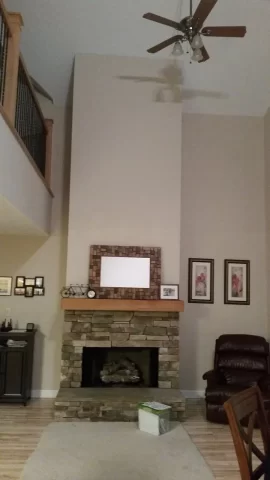
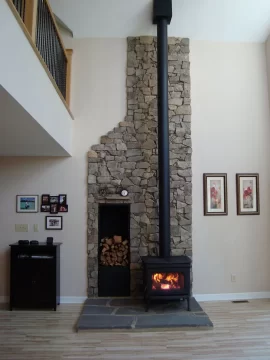
If you got to this thread googling, “which wood stove is best” I thought I’d type up my experience and thoughts and maybe save you some hours of reading by compiling and paraphrasing others' good advice. I do hope you read a bunch on this forum. I enjoyed it immensely while I was freezing this winter, spending a fortune on propane, and imagining next winter in warmth and bliss... but if you can't spend hours and hours or are in a hurry to get your stove in before winter, maybe this will be useful.
Here is what I gleaned from reading and, most of it reflects my actual process. These thoughts are NOT my original ideas, but things I picked up from reading 100s (probably 1000s) of posts here at hearth.com. This forum is GREAT and the folks here are very knowledgeable and helpful and believe me they want you to LOVE your stove experience so don’t be shy.
1. “Which stove is best” depends on a bunch of factors. The better question is, “which stove is best for my specific situation?” If you’re a newbie, it takes a bit to figure out your specific situation. Face it, we don’t even really know where to start!! Important things to consider are, how big is the space you want to heat? How tall will your chimney have to be (different stoves perform better/worse with different height chimneys)? How much space do you have? This last question is likely going to narrow your choices so you have a more manageable number of stoves to chose from. If you’ve got limited space, a corner install, an alcove or what have you, you will probably find some variation in clearances to combustibles and you should know all this before you fall in love with a model that won’t work in your space. There are MANY posts on this point so if you don’t know, just search a few models and you’re likely to get some ideas based on your situation.
Here’s an example of what I mean: I wanted a different model than the one I bought at one point, but I have a vaulted 23’ ceiling and I read every word about this model and learned that it doesn't do well with tall chimneys and then read the manual. That one got nixed because, while I still think it’s an awesome stove, for my situation, it would have been not the best stove no matter how many loving reviews by satisfied owners I read. Reading solely about the stove and performance and specs wouldn’t have made me eliminate this as a choice. More often, stoves require taller chimneys so if you only have one story, be sure to read up that too to be sure your choice is good for your situation.
So, my point is that you should really have a good idea where you want your stove, where the chimney is going to be and can you have it stick up really high (in the case of a Class A with a steep pitch) in that spot? How much room will you have on all 4 sides of the stove to meet local codes for clearances to combustible in all 4 directions? There are probably other considerations, but these seem to me to be the more important “before you start” issues to work out. In short, don't go down the "which brand?" rabbit hole too soon.
Another point about how big of a stove to get: You will read a lot on this forum that a bigger firebox is generally desirable if you can fit it. I must have read a dozen times (or more) that you can build a small fire in a big firebox but you can’t build a big fire in a small firebox. So, my advice is to shop a size larger, generally, than you think you’d need and check the specs on that to ensure it can fit with clearances in the manual. If your space is tight, you can’t maybe do that.
2. Pick the dealer before you pick the stove. I read this several times before I bought my stove and I didn’t follow this advice. I wish I would have. I know I’ll be happy with my stove but I can already tell you that I’m going to have to find a different vendor for cleaning and inspection in the future. I had some stress related to my installation that was, frankly, 100% totally unnecessary. It would have been EASY for them to help me get through some of the details but they made it hard and treated me like I was an idiot. It was just not good customer service. Even though I’m deliriously happy right now as I type this since the end product is GREAT, I’m not inclined to give them my follow up business. The difference between most models doesn’t seem to me to warrant picking a dealer you don’t like to get some incremental spec/benefit. If I didn't pay a hefty deposit, I would have changed vendors and stoves. It was too late for me when I became unhappy with my dealer.
If you plan to have a wonderful relationship with your wood burning stove for years to come, it seems to me you should have an equally wonderful relationship with someone who can answer your newbie questions and make you feel comfortable during demolition, construction and installation. I think you should pick someone from whom you feel like you’ll get excellent service from the start and over the years as you need cleaning, new firebricks and the like.
3. Cat or non-cat. Maybe this should be #2 instead of #3 since some dealers specialize in ONLY cat stoves. I chose non-cat. I did this because I am a newbie and I just didn’t want one more thing to maintain. It probably isn't as complicated as some of the websites make it seem, but for my first one, I thought I'd keep it as simple as possible and still meet my needs. I have the luxury of not having to need a cat stove because I live in Western NC where it gets below 15 degrees about 2 days a year so if my fire goes out in the middle of the night, I’m not likely to be too miserable. Hell, I might not even get cold. If you’re reading this and you’re in Saskatoon or similar climate, you might not have this choice (but, if you’re in Saskatoon, you’re probably not a newbie either)! Cat or non-cat is like religion for some and there are whole threads on this so read on if you want more. To oversimplify, I would just say that you should consider how long you need a burn, what the issues are if the fire goes out, and what maintenance/catalytic replacement expense are you willing to take on. I think this overly-simplistic statement on it is going to open a can of worms for the seasoned veterans who can probably write a treatise on cat vs. non-cat...
4. What do you like? Since I haven’t had many stoves, I started this process with literally NO bias towards one vendor or another. I'd never even heard of any of the companies. After you’ve sorted out the items above, I think you can’t really go wrong choose what you like the look of. Some models have colored enamel paint, some are metal, some are cast iron, some have nice iron work on the glass, some are round and modern looking, some are very rustic looking... heck, one model even has an indoor grill option! By the time you’ve narrowed your list based on the considerations above, I would probably just pick the one you like the best. It seems to me that there really isn’t that much difference between each of the vendors (for comparable models) -- at least there wasn't to my naive eyes. If you’ve made it this far and you have a “short list” of 3 or 4, read up on ‘em here and pick the one that has the features and design you like best. But remember that what is "best" for one might be "worst" for your application so don't forget what you learned in #1 above and be swayed by a great review without ensuring it doesn't require an environment that your home and set up can't provide.
5. Feel comfortable after you choose that you got a good stove. If you picked something that works in your space and situation, and you still have issues, be sure first your wood is properly seasoned (i.e. moisture check) and then post your question/issue here! The theme I saw many times reading this forum was that most of the problems were due to people not picking a good stove for their situation/space or burning crappy, unseasoned wood. I can’t recall a situation where someone got a genuine lemon. This reiterates why I think it's good to have a good dealer. In my situation, if my stove has issues, I'm NOT comfortable with my dealer so I will have to rely on another one that doesn't sell my model or this forum for help. Not ideal for a newbie, but I'm confident my stove is going to work great because, well, they all more or less do unless you did something wrong in step 1 in assessing your needs, floor plan, clearances, etc.
Now, you may be asking, what did I get???
So, I ripped out a ventless gas set up. It smelled, provided not much in the way of heat, cost a fortune in propane and had absolutely no soul whatsoever. I had considered a zero clearance fireplace for months before settling on the stove. There were many reasons for this and this post is long enough so write me if you want to know more about my choice, but the main issue was that it was more costly and I would needed a blower and there were lots of posts about the noise blowers make. No dis on those that have FPs, but I just decided it wasn’t for me after some homework.
I got the Pacific Energy Alderlea T6. I have 2300sqft+ with a large vaulted ceiling with a 2 BR loft overhanging the great room. The floor plan is very open and has a 23' ceiling so I was only looking at the biggest models by vendor. I posted before/after pictures. I hope you like them!
Thanks to everyone who was SO HELPFUL on my journey. This was my favorite EVER home improvement project -- and I've done a fair amount of them over the years in various homes. Probably, if you posted here, you helped me even if you didn’t know it. I swear I’ve read nearly every word on this forum during my journey!! I'm so glad I found you.


Last edited:


 That is a beautiful installation. How is the stove working out with the cathedral ceiling and the loft? What are you using to even out the heat in the loft and high ceiling area and how is that working out for you.
That is a beautiful installation. How is the stove working out with the cathedral ceiling and the loft? What are you using to even out the heat in the loft and high ceiling area and how is that working out for you.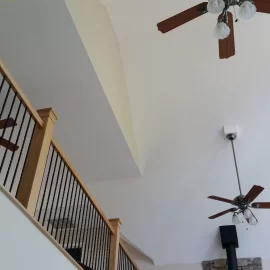
 (You are doing that, right?)
(You are doing that, right?)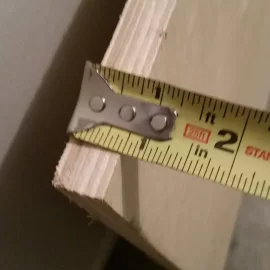
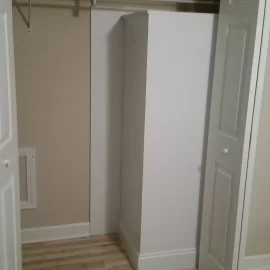
 Best of luck
Best of luck